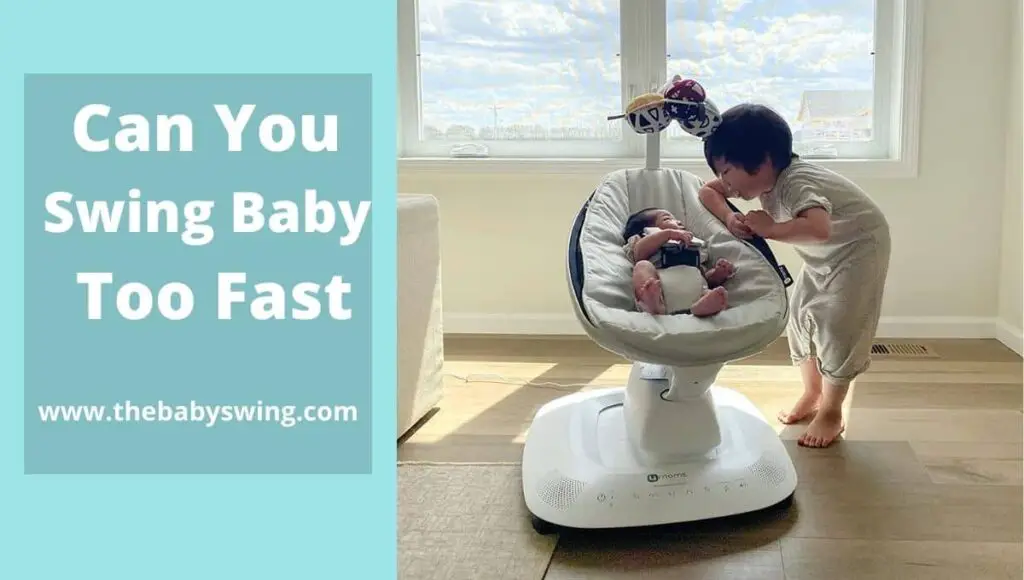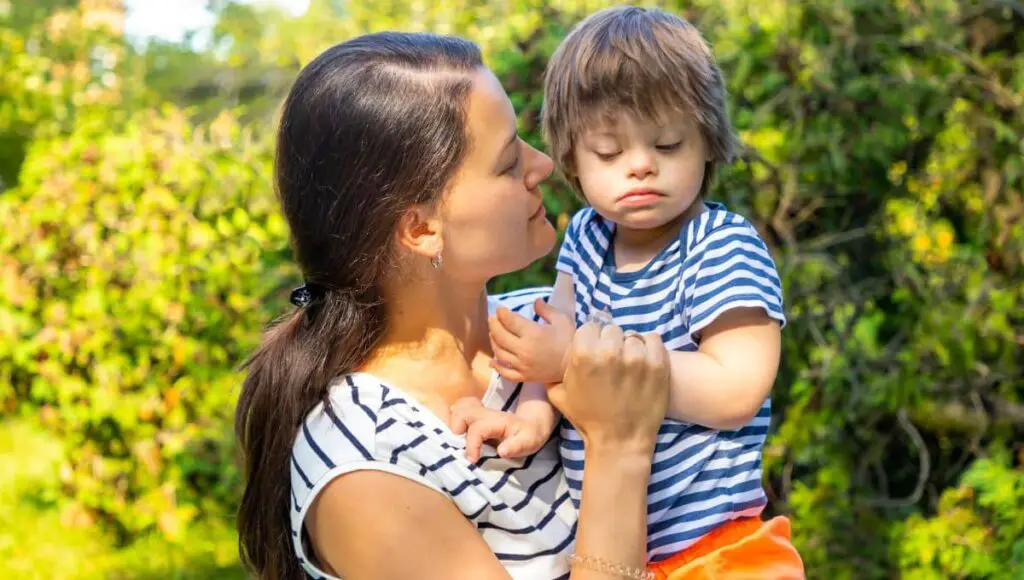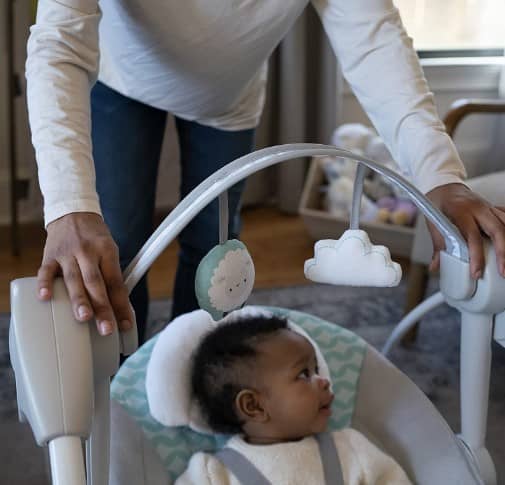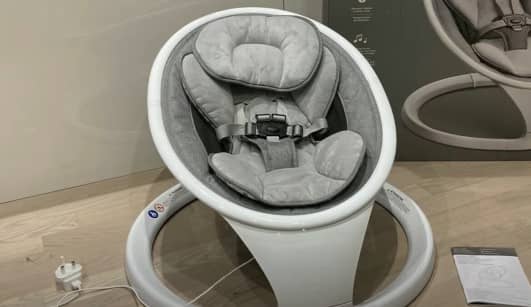Last Updated on July 17, 2023
Can you swing baby too fast? The answer to this question is a resounding “YES!” You can actually cause serious injury to your child if you swing them too hard or too fast.
A baby swing is a well-cushioned chair that swings back and forth (or side to side) like the womb’s rocking motion. It is used to soothe and calm a baby and can be a lifesaver for parents who need a break.
The American Academy of Pediatrics (AAP) recommends that babies be placed in swings “for no more than 30 minutes at a time.” They also recommend that the swing’s speed be set no faster than “medium” and that it should never be left unattended.
In this blog post, we will discuss whether or not you can swing your baby too fast and what the consequences may be. We will also provide some tips for parents who want to introduce their children to the joys of swinging!
- Can you swing baby too fast?
- What happens if you swing your baby too fast?
- Can swing a baby cause brain damage?
- What movements can cause shaken baby syndrome?
- Can bouncing babies cause shaken baby syndrome?
- How fast can you swing a newborn?
- Should you adjust the swing speed to age?
- Can a standard baby swing be too fast for babies?
- How do baby swings relate to accidental deaths and SIDS?
- When should you stop swaddling your baby?
- Tips on using a baby swing safely:
- FAQs
- The Takeaway
Can you swing baby too fast?

Swinging can be a great way to soothe your baby and help them get to sleep. However, you shouldn’t swing a baby too quickly, even though swinging a baby faster is theoretically possible.
It can cause the baby to become injured. Sometimes, it can lead to death which is known as Sudden Infant Death Syndrome (SIDS).
Some parents swing their babies too fast because of their anger if the baby doesn’t stop crying, which can be extremely dangerous. If you have anger issues, it is best to find another way to deal with your anger rather than swinging the baby too fast because it can have tragic consequences.
Just make sure that you don’t swing them too hard or too fast! Gentle swings are the key to a peaceful baby. When the baby gets older, you can increase the swing speed gradually to get used to the movement. But you should always keep the baby under watch while swinging.
Related Read: When can you put a baby in a baby swing
What happens if you swing your baby too fast?
The shaken baby syndrome is catastrophic brain damage that occurs when a baby or young child is violently shaken.
If you swing your baby too fast, they can become dizzy and nauseous. The rough movement might also damage the retina (the light-sensitive back of the eye), causing partial or complete blindness.
They can be injured if you swing them too hard or too high. Babies are fragile and their bones are not yet fully developed, so it is important to be careful when swinging them.
The force of the collision kills the baby’s brain cells and prevents oxygen from reaching the brain. The shaken baby syndrome is considered to be a form of child abuse.
Can swing a baby cause brain damage?
Swinging a baby too fast and too high might cause brain damage. Shaking a baby or toddler might result in their head striking the inside of their skull over and over. Bruising, bleeding, and swelling in the brain can all be caused by this impact. Other problems that may occur include fractured bones and injuries to the infant’s eyes, spine, and neck.
So, it is important to be cautious when swinging a baby and to always hold onto them securely. It is also advisable to avoid swinging a baby too high or too fast, as this could potentially lead to injury.
Some statistics show that swinging a baby, even momentarily, can result in permanent brain damage. The consequences may be serious and long-lasting, including:
- Partial or total blindness.
- Developmental delays, learning difficulties,
- Behavioral problems.
However, if you have any concerns about swinging a baby, it is best to speak to a healthcare professional for advice.
What movements can cause shaken baby syndrome?

There are a few different types of movements that can cause the shaken baby syndrome.
– When a baby’s head is suddenly and violently thrown backward and forward, this can cause the brain to hit the inside of the skull, leading to bleeding and damage.
– Another type of movement that can cause shaken baby syndrome is when the head is rotated quickly. This can also cause bleeding and damage to the brain.
– Other types of violent shaking of the body can also cause damage to the brain if it is done with enough force. These types of movements can lead to serious injury or death if they are not treated immediately.
– And the most dangerous part of the delicate brain of a newborn is violently shaken, flipping back and forth inside the skull. Bruising, swelling and bleeding are all caused by this.
– Lastly, the Shaken baby syndrome is most often induced when a parent or caregiver severely shakes an infant or toddler due to irritation or anger – particularly if the baby will not stop crying.
Can bouncing babies cause shaken baby syndrome?
The shaken baby syndrome is a condition that can occur when a baby is bounced too hard or for too long. It is not caused by gentle bouncing, playful swinging, tossing the child in the air, or jogging with him. It’s also uncommon to get it from accidents such as falling off chairs or down steps or inadvertently being dropped from a caregiver’s arms.
Sometimes the bouncing babies can cause the baby to become agitated and irritable and can also lead to the shaken baby syndrome. Aggressive Shaking baby syndrome symptoms are a serious condition that can result in brain damage and even death. If you suspect your child has either of these conditions, it is important to seek medical attention immediately.
How fast can you swing a newborn?

Most parents should swing a newborn baby gently. You should use the lowest speed settings of a swing for the first few weeks after the baby is born.
It’s because newborns are fragile and their weak neck muscles are not yet strong enough to support their heads if they are swung around too vigorously.
A good rule of thumb is only to swing the baby just high enough so that their feet leave the ground. This will help prevent any injuries and keep the baby safe and comfortable.
Should you adjust the swing speed to age?
Experts recommend that you should adjust the swing speed to age. And you should use the lowest setting for a newborn for the first few weeks. After that, you can start to increase the swing speed gradually.
Plus, many parents find that starting with a slower swing speed and gradually increasing it as their baby gets older works well. You can also try different speeds to see what your baby prefers.
Most baby swings have specific guidelines, generally centered on weight limits rather than age restrictions. Check your baby swing’s manufacturer’s guide for further information.
Regardless of their age, be nearby to observe them while they use a baby swing. Ultimately, paying attention to your baby’s cues and adjusting the speed accordingly is important.
Can a standard baby swing be too fast for babies?
Most baby swings’ standard speed settings are just perfect for newborns. However, some babies may find a standard baby swing too fast, while others may enjoy the faster pace.
Ultimately, it is up to the parents to experiment with different speeds to see what their child enjoys the most.
If you find that your baby is uncomfortable or seems unhappy with the standard speed, you can always try slowing it down a bit to see if that makes a difference.
But above all, it should be ensured that the child does not feel any inconvenience.
How do baby swings relate to accidental deaths and SIDS?

Using a baby swing is safe if you follow the manufacturer’s instructions and stop using it before your baby reaches its maximum weight limit.
However, some experts believe that baby swings may contribute to a small risk of both accidental death and SIDS due to the fact that they can provide a safe and comfortable environment for a baby to play and soothe.
This may lead to parents forgetting to check on their child regularly or not noticing if their child has stopped breathing. While there is no definitive proof that baby swings are dangerous, it is always important to be vigilant when using any type of baby product and to follow all safety guidelines carefully.
When swinging a baby too fast, the baby’s brain shifts rapidly inside of the skull, and fragile blood vessels in SBIS tear. The high pressure within the confined region strains the brain and eyes. Sometimes, when a breastfed baby is shaken violently, their retina (the light-sensitive back of the eye) can be detached, resulting in blindness. In extreme cases, a newborn’s death might be caused by a swing that is too quick.
When should you stop swaddling your baby?
The answer to this question depends on your baby’s age, development, and sleep habits.
For most babies, it is recommended that you stop swaddling when they are between two and four months old. This is typically your child may be capable of rolling onto their tummy while they can’t yet roll back over at this age. However, some babies may need to be swaddled for longer, depending on their individual sleep patterns.
If your baby is older than 3 months and still wakes up frequently during the night, or if they seem uncomfortable when you try to swaddle them, it is probably time to stop.
You can do a few things to help your baby transition out of being swaddled. Try slowly decreasing the amount of time you swaddle your baby each night. For example, if you normally swaddle them for 2 hours, try only doing it for 1 hour the first night.
You can also try using a lighter weight blanket or a sleep sack instead of a full swaddle. This will give your baby the security of being wrapped without being too constricted.
Talk to your pediatrician if your baby is having trouble sleeping through the night. They may have some additional suggestions on how to help your baby sleep better.
Tips on using a baby swing safely:

– When using a baby swing, always make sure that the seat is in an upright position.
– Never leave your child unattended in a swing.
– Always use the safety harnesses when your child is in the swing.
– Make sure the swing is on a level surface before using it.
– Be careful not to overload the swing with too many toys or blankets, as this can cause tipping.
– Inspect the baby swing regularly for rips, tears, or loose parts. Do not use the swing if it is damaged.
If you follow these simple tips, you can ensure that your child will have a safe and enjoyable experience in their baby swing!
FAQs
The Takeaway
It’s always important to be mindful of safety when it comes to our children. While swinging a baby might seem like fun and harmless play, it’s important to make sure that you’re following the recommended guidelines for how fast to swing a baby in a baby swing. Swinging too fast can cause serious injury to a child, so please be careful! Thanks for reading and keeping your children safe.

Amy A. Vincent is a Certified Pediatric Sleep Consultant and a mother of three beautiful children. She helps parents transition their babies from swing sleep to safe, independent sleep. She is passionate about helping parents teach their children the skills needed to become good sleepers and aims to make the process as easy and stress-free as possible. Read more
